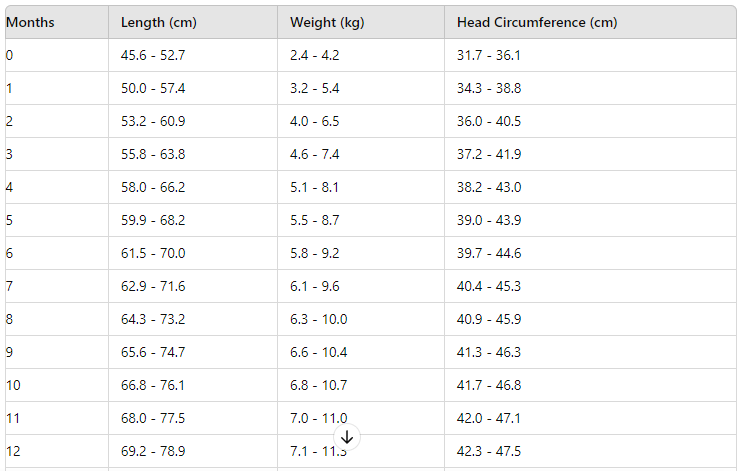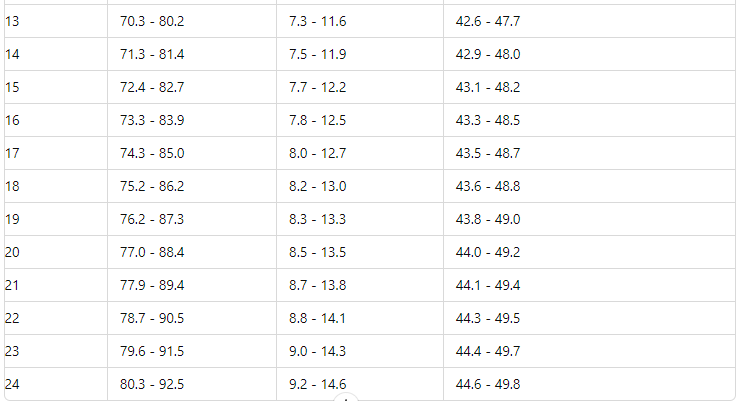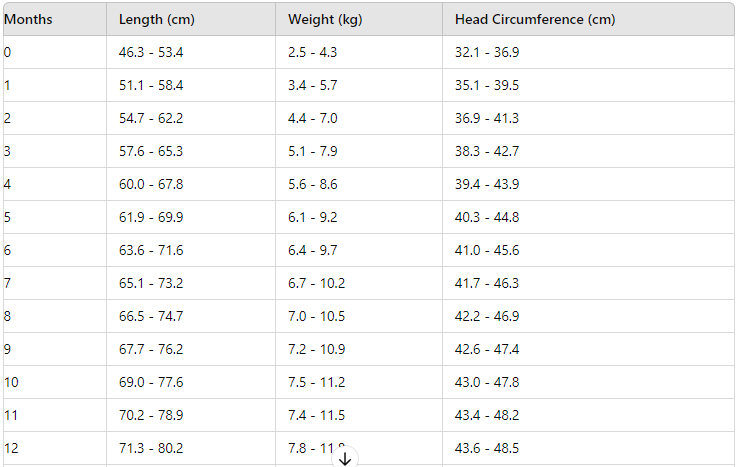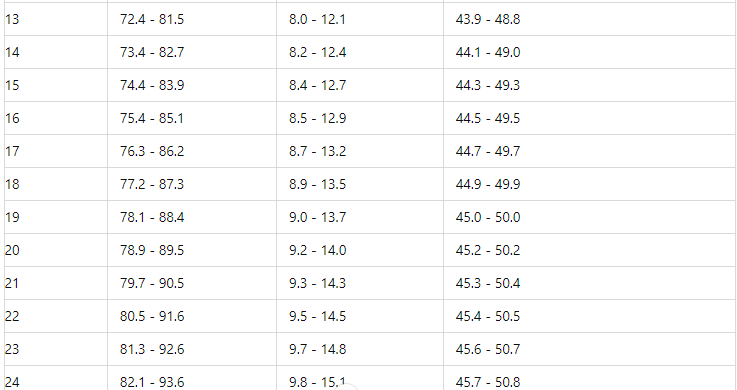Indian Baby Growth (Height and Weight) Chart (0 to 12 Months)
Are you concerned about your baby's growth? Understanding the Indian baby height and weight chart can help you track your little one's development accurately. This guide covers everything from the importance of growth charts to factors influencing height and weight, ensuring you can monitor your baby's health effectively.
Importance of Baby Weight Charts
The baby weight chart, also known as a Growth Chart, plays a vital role for both parents and pediatricians. It provides a standardized tool to assess your child's nutritional status and overall growth trajectory during the crucial first year. Monitoring your baby's height and weight helps ensure they are on track with their physical development and provides insights into their nutritional needs and potential health issues.
Resources:
Indian Academy of Pediatrics (IAP): https://iapindia.org/iap-growth-charts/ (Provides downloadable Indian baby growth charts)
World Health Organization (WHO): https://www.who.int/tools/child-growth-standards/standards (Offers a global perspective on child growth standards)
Growth Patterns and Individual Variations
Every baby is unique, and their growth patterns will vary. Some babies may be chubbier, while others may be leaner. The growth chart provides a standardized way to compare your baby's measurements against national averages. This allows pediatricians to identify any deviations early on, whether your baby falls below the 3rd percentile or exceeds the 97th percentile. Keep in mind that these percentiles represent a range of healthy growth patterns, and not all babies will fall perfectly within the middle range.
Understanding the Height and Weight Chart
Birth to 12 Months:
Newborn Stage: At birth, both baby boys and girls generally have similar height and weight patterns. On average, a newborn weighs between 2.5 to 4 kg and measures about 48 to 53 cm in length. ([Source: IAP Growth Charts](URL indian academy of pediatrics weight chart ON iapindia.org))
First Year Growth: During the first year, babies experience rapid growth. By the time they reach 12 months:
Boys: Typically weigh between 7.8 to 11.8 kg and measure 71.3 to 80.2 cm in length.
Girls: Generally weigh between 7.1 to 11.3 kg and measure 69.2 to 78.9 cm in length. ([Source: IAP Growth Charts](URL indian academy of pediatrics weight chart ON iapindia.org))
Factors Influencing Baby's Height
Several factors impact your baby's height, including:
Genetics: These play a significant role in determining your baby's potential growth.
Nutrition: Ensuring a balanced diet rich in essential nutrients, including protein, calcium, and vitamins, promotes optimal growth. ([Source: World Health Organization - Infant and young child feeding](URL infant and young child feeding who ON World Health Organization who.int))
Environmental Conditions: Adequate sleep and physical activity contribute to a baby's height development. Provide a safe environment for your baby to move freely and explore their surroundings.
Overall Health: Underlying health issues can affect growth. Regular checkups with your pediatrician can help identify and address any concerns.
Weight Gain Patterns
Weight gain is equally critical for your baby's health. Most babies double their birth weight by five months and triple it by twelve months. According to the World Health Organization, babies typically gain approximately 900 grams per month in the first three months and about 600 grams per month from four to twelve months. However, these are average figures, and individual variations may occur.
Monitoring and Intervention
Regular visits to your pediatrician for height and weight measurements are essential for tracking your baby's progress accurately. If your baby's growth deviates significantly from the normal range, it may signal underlying health issues requiring further evaluation and intervention. Prompt medical attention ensures timely adjustments to diet, lifestyle, or treatment as needed.
Understanding and utilizing the height and weight chart for Indian babies empowers you to monitor your baby's growth effectively, identify any concerns early, and collaborate with healthcare providers for optimal care. By staying informed and proactive, you can ensure your baby thrives physically and enjoys a healthy start in life.
Additional Considerations for Parents
Here are some additional details and considerations for parents to keep in mind regarding their baby's growth:
Red Flags to Watch Out For:
Slow or no weight gain: If your baby isn't gaining weight consistently, especially in the first few months, consult your pediatrician.
Excessive weight gain: Rapid weight gain can also indicate underlying health issues.
Poor feeding habits: Difficulty latching, refusing to eat, or excessive spitting up could be signs of a problem.
Loss of milestones: Missing developmental milestones could be a red flag.
Promoting Healthy Growth:
Breastfeeding: Breast milk provides optimal nutrition for babies and promotes healthy growth. Aim for exclusive breastfeeding for the first six months, if possible.
Balanced Diet: After six months, introduce solid foods gradually. Ensure a balanced diet rich in fruits, vegetables, whole grains, and protein sources.
Sufficient Sleep: Newborns need around 16-18 hours of sleep per day. As they grow older, their sleep needs decrease, but adequate sleep remains crucial for growth and development.
Regular Checkups: Schedule regular well-child visits with your pediatrician to monitor growth, development, and immunizations.
Remember: Every baby grows at their own pace. The growth chart is a guide, and some variations are normal. However, if you have any concerns, don't hesitate to discuss them with your pediatrician.
Girl Growth Chart: (Source Apollo)


Boys Growth Chart: (Source: Apollo)


Here are some questions with answers about baby weight in India, keeping in mind average weight gain and the importance of consulting a pediatrician:
How much weight should a baby gain per month in India?
The average weight gain for babies in India varies depending on their age:
First 3 Months: Around 900 grams per month ([Source: World Health Organization](URL infant and young child feeding who ON World Health Organization who.int))
4 to 12 Months: Approximately 600 grams per month ([Source: World Health Organization](URL infant and young child feeding who ON World Health Organization who.int))
Important Note: These are averages, and individual variations are normal. Some babies might gain weight more quickly or slowly as long as they are following a healthy growth trajectory.
Is 7kg normal for an 8-month-old?
While it's difficult to say definitively without more information, 7kg could be within the normal range for an 8-month-old baby in India. Here's why:
Growth Charts: Refer to Indian baby growth charts from the Indian Academy of Pediatrics (IAP) (https://iapindia.org/iap-growth-charts/) for a more precise picture. These charts show weight ranges based on percentiles.
Individual Variations: Every baby grows at their own pace. As long as your baby shows a steady and healthy weight gain pattern, 7kg might be perfectly normal.
Is 2.2 kg baby weight normal?
2.2 kg is on the lower end of the typical birth weight range for a newborn in India, which is generally between 2.5 kg and 4 kg. However, it's crucial to consider:
Newborn Weight Loss: Newborns typically lose some weight (around 5-7%) in the first few days after birth, but regain it within 10-12 days.
Premature Birth: If the baby was born prematurely, their weight might be lower than average.
Is a 4.5 kg baby normal?
4.5 kg falls well within the typical birth weight range for a newborn in India (2.5 kg to 4 kg).
Is 5kg normal for a 4-month-old baby?
It's difficult to say definitively without more information. However, 5kg could be within the normal range for a 4-month-old baby in India. Here's why:
Growth Charts: Refer to Indian baby growth charts from the Indian Academy of Pediatrics (IAP) (https://iapindia.org/iap-growth-charts/) for a more precise picture. These charts show weight ranges based on percentiles.
Individual Variations: Every baby grows at their own pace. As long as your baby shows a steady and healthy weight gain pattern, 5kg might be perfectly normal.
Can I deliver a 4kg baby naturally?
The possibility of delivering a 4kg baby naturally depends on various factors, including:
Your Pelvis Size and Shape: A doctor can assess this through measurements or imaging.
Baby's Position: Ideally, the baby should be head-down for a vaginal delivery.
Your Overall Health: Factors like your medical history and any existing conditions play a role.
Doctor's Recommendation: They can guide you based on a comprehensive assessment.
Important Note: While some women deliver babies weighing 4kg or more naturally, it's not guaranteed. Discuss your birth plan and any concerns with your doctor to determine the safest and most suitable delivery option for you and your baby.
How many kg is good for normal delivery?
There isn't a single "good" weight for a normal delivery. Birth weight is just one factor considered. Healthy vaginal deliveries can occur with babies ranging from a healthy birth weight (typically above 2.5 kg) to higher weights depending on the factors mentioned above.
What is the maximum weight for normal delivery?
There's no single maximum weight for a normal delivery. However, doctors might recommend a C-section for various reasons, including:
Estimated Fetal Weight (EFW): If the EFW suggests a very large baby, a C-section might be safer.
Maternal or Fetal Health Concerns: The doctor prioritizes mother and baby's well-being, and a C-section might be chosen for health reasons.
How big baby for C-section?
Baby size isn't the sole determinant for a C-section. It depends on a comprehensive assessment by your doctor.
What is more painful, a C-section or a natural birth?
Pain perception is subjective. Both C-sections and natural births can involve pain.
C-section: Involves surgery and carries post-operative pain.
Natural Birth: Can involve pain during labor and delivery.
Which baby is healthy, normal or C-section?
Both normal and C-section deliveries can result in healthy babies. The delivery method itself doesn't determine a baby's health. What matters is that the delivery happens safely and the baby receives appropriate care after birth.
Is a C-section less risky for a baby?
C-sections can sometimes be safer for babies, particularly in situations with complications like breech presentation or fetal distress. However, both delivery methods carry potential risks, and your doctor will recommend the option that minimizes risks for both you and your baby.
Don't hesitate to ask your doctor detailed questions about your specific situation and the best course of action for your birth. They can provide personalized guidance based on your medical history and current health.
Important for All Cases:
While these weight ranges offer some guidance, it's always best to consult a pediatrician. They can assess your baby's growth pattern, overall health, and feeding habits to determine if their weight is within a healthy range for their individual development.
Additional Resources:
Ministry of Health & Family Welfare, Government of India: https://main.mohfw.gov.in/ (Provides information on child health and development programs in India)
National Institute of Nutrition (NIN): https://www.nin.res.in/ (Offers resources on infant and child nutrition)
By incorporating these additional sections and resources, the article becomes even more comprehensive and informative for parents seeking to understand and monitor their baby's growth and development using the Indian baby weight and height chart.




What did you think of this article?
We value your feedback and would love to hear your thoughts on this article.
Write to: hello [at] watchdoq [dot] com with questions or comments.
Additional Resources